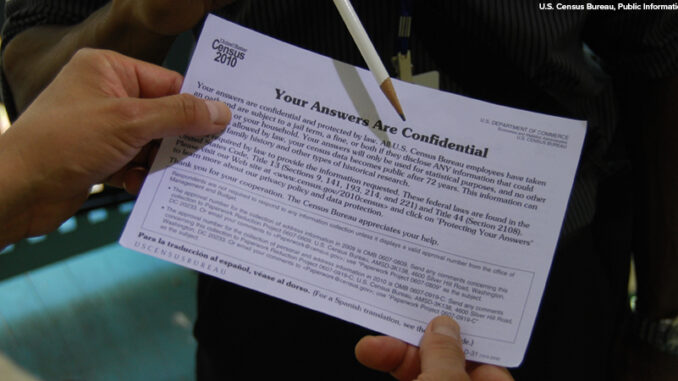
The Commerce Department of the federal government is responsible for conducting a census of the United States’ population every ten years. Having an accurate number of the population is important today for many reasons. But originally the Constitution of the United States based the need for this data in Article 1, Section 2, clause 3: “Representatives and direct Taxes shall be appointed among the several States which may be included within this Union, according to their respective Numbers. . . . The actual Enumeration shall be made within three Years after the first Meeting of the Congress of the United States, and within every subsequent Term of ten Years, in such Manner as they shall by Law direct.”
Originally, the Constitution did not count Native Americans and did not fully count enslaved people. But when the Fourteenth Amendment was ratified in 1868, the wording and meaning of this clause has been changed. It required that “the whole number of persons of each state” be counted as civil rights have been expanded to all men and women, regardless of race.
Recently, however, President Trump announced that he wanted the Census to be conducted differently. He wants to exclude illegal immigrants from the population count.
How is the Census Conducted?

Did you know that the once-a-decade Census is the largest non-military activity undertaken by the federal government? The Commerce Department temporarily gathers volunteers for each census and these individuals go throughout their communities with official government questionnaires. These volunteers also encourage people to go online and fill out digital versions of the census questions if they do not want to complete the information by hand and mail it in. They also have the option to respond to census questions by telephone.
The census takers ask people to fill out the forms and provide all sorts of information, including the number of people within each household, their ages, race, income, employment status, and more. This massive amount of data is used by Washington D.C. to ensure basic things such as the overall population of each state. This sets the number of representatives that each state gets in the federal House of Representatives. And therefore, it also determines the number of Electoral College votes given to each state during presidential elections.
All of the other data helps many of the other government agencies fine tune their responsibilities and future actions. The government uses the data to effectively distribute billions of dollars in federal money every year. The state and local government also rely on census data to make accurate decisions on where new schools should be built, how social services should be planned, and even where new transportation improvements are most needed.
Trump’s Focus on Citizenship and the Census
Article I of the Constitution describes the structure and powers of the legislative branch. So, the responsibility of organizing and fulfilling a census is the responsibility of Congress. The 1790 Census Act established the rules of the first national census. And in modern history, Title 13 of the U.S. Code established the Census Bureau within the Commerce Department. So, Congress has oversight responsibility for this important task. But the president’s recent remarks suggest that he wants the executive branch to take over the role of shaping how the census is done, when it is done, and how the data is used.
During Trump’s first term in the White House, he wanted to add a citizenship question to the census. At the time, he complained on social media that a census questionnaire that didn’t ask about citizenship would have “meaningless” results. The Supreme Court in 2019 prevented this question from being added. But that doesn’t mean that citizenship questions have never been asked by the Census Bureau. In the 1950 Census form, one of the 40 questions included a query about someone’s birthplace and further if someone born out of the United States had become a naturalized citizen. (Naturalization is one way to become a U.S. citizen by formally applying for citizenship and fulfilling a set of requirements.) The citizenship question was removed from the 1960 main questionnaire that was sent to every household.
Congressional Numbers
Trump’s statement on the Census was made amidst the recent Texas redistricting controversy. As such, observers suggest that this may be another effort to provide numerical advantage to Trump’s Republican party in the upcoming 2026 midterm elections and even the 2028 presidential election. Some news observers wondered if Trump was trying to get the Census Bureau to act before the regularly planned 2030 census with this exclusion of illegal immigrants as part of the data. Such new data, if it could be gathered and applied to congressional districts, might change the influence of the political parties across the country.
But conducting a Census is a very difficult and complicated undertaking. And even if it could be done sooner than 2030, collecting and applying the gathered statistics to any future government action or redrawing of congressional district maps would likely be a slow and political process. So, it is very unlikely that any of this could have a direct effect on upcoming federal elections.
